Global Education E-Conference, Nov. 16th, 2012
Download as ppt, pdf1 like3,190 views
The document discusses the importance of global education in developing students' awareness and competence through analysis of international sources and problem-based learning (PBL) projects. It emphasizes the need for students to engage with diverse cultures and issues to foster critical thinking, empathy, and social action. Additionally, it outlines teacher strategies for facilitating PBL, utilizing web 2.0 tools, and assessing student projects effectively.
1 of 24
Download to read offline

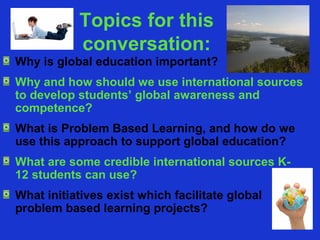

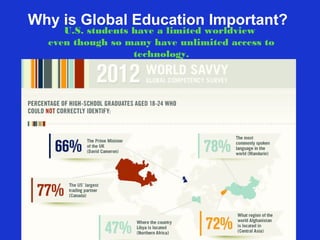

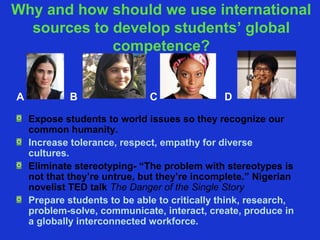
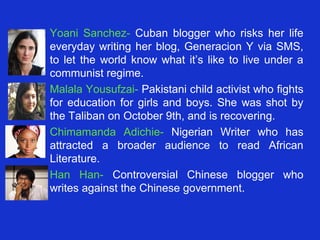

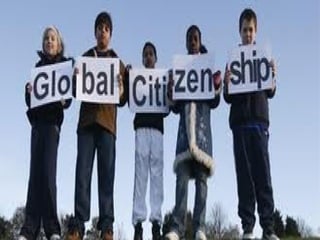

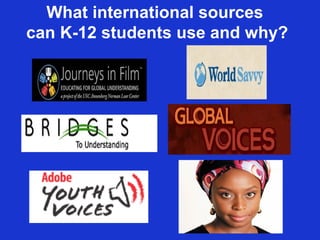
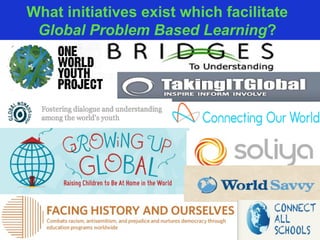
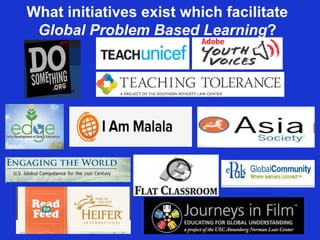
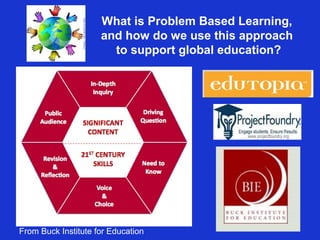

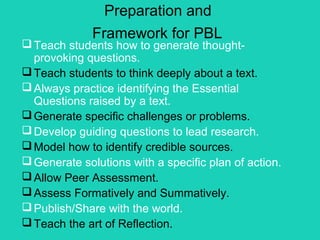
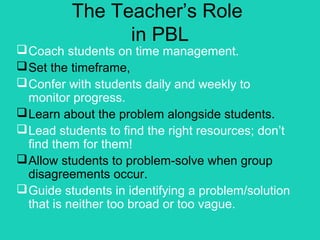
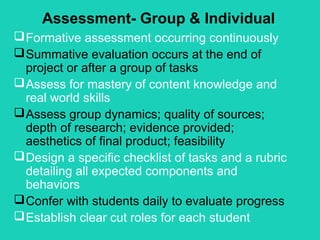
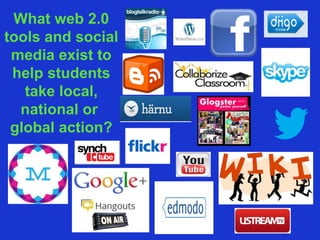
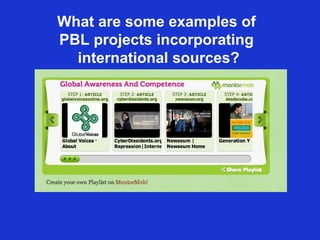
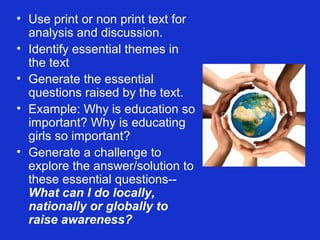
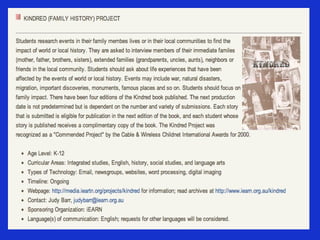
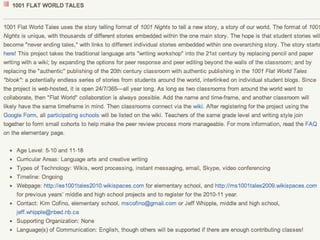

Ad
Recommended
Presentation global conference1
Presentation global conference1Ary Mas-Aranguiz
╠²
The document discusses using international sources and problem-based learning to develop students' global competence. It recommends exposing students to world issues through blogs, newspapers and literature from other countries to increase cultural understanding. Problem-based learning projects that incorporate international texts on global issues can help students recognize our shared humanity. The document provides examples of credible international sources and initiatives that facilitate global problem-based learning, as well as guidance on designing such projects and using social media for students to take local, national or global action.Navigating the Landscape of the 21st Century Classroom by Dr. Julie Carter
Navigating the Landscape of the 21st Century Classroom by Dr. Julie CarterLightspeed Technologies
╠²
The document discusses the landscape of the 21st century classroom. It notes that modern classrooms are flexible, mobile, collaborative, and technology/device rich. They are designed to foster collaboration with movable furniture and communal spaces. 21st century skills like cooperation are emphasized. However, challenges exist with the influx of devices, including loss of classroom management control, connection to individual students, and reduced time productivity. Teachers must learn to regain control through routines, formative assessments, and embracing technology for feedback while only using devices when appropriate.3 rs x 7cs 21st century skills - convention
3 rs x 7cs 21st century skills - convention bgalloway
╠²
The document discusses 21st century skills and learning. It defines the key concept of 21st century skills as involving collaboration, critical thinking, problem solving, creativity and innovation. It explores digital tools that can be used to teach 21st century skills and examines evidence around defining 21st century learning. The document also discusses inspiring education in Alberta and engaging students as 21st century learners.21st century 2013
21st century 2013Markcacciatore
╠²
This document discusses 21st century learning and perspectives from various educational theorists. It explores how classrooms may evolve to incorporate more technology, collaboration, and personalized learning. Challenges are noted around ensuring all students benefit from new approaches and addressing issues like cyberbullying. The document advocates engaging students through digital books, apps, and online discussions to prepare them for today's world.20 vs 21 Century Schools (newport pres)
20 vs 21 Century Schools (newport pres)ccapozzoli
╠²
The document compares 20th century and 21st century education, outlining key differences. In the 20th century classroom, teaching was teacher-centered with a focus on memorization and passive learning. In contrast, the 21st century classroom emphasizes student-centered, collaborative and active learning through integrated, technology-enhanced projects. It stresses skills like critical thinking, communication and digital literacy to prepare students for future success in a globalized world. The document argues that educators must continue evolving practices through professional learning communities to ensure students have rich 21st century learning experiences.Pedagogical design for honors study abroad and beyond
Pedagogical design for honors study abroad and beyond Beata Jones
╠²
The document discusses pedagogical design for honors study abroad programs, emphasizing the need for effective program design and clear learning goals to facilitate significant learning experiences. It outlines strategies for engaging students in creating diverse and interdisciplinary curricula, including the importance of intercultural knowledge and assessments tailored to enhance global learning. Finally, it provides a framework for educators to develop study abroad modules and encourages sharing resources among participants.Real life assessment Valerie Bryant
Real life assessment Valerie Bryantvdbryant
╠²
This document discusses formative and summative assessment in language learning. It provides examples of formative assessments that teachers can use in the classroom, such as sharing student work videos, using stoplights to gauge understanding, and short intense speaking activities. It also includes links to additional resources on using formative assessment and examples of formative assessment projects like having students participate in a classroom green screen travel activity. The document emphasizes that formative assessment should provide clear learning targets and feedback to help students understand expectations and improve.Deanz cbam
Deanz cbamDerek Wenmoth
╠²
The document discusses the challenges organizations face with adopting open and distance learning, identifying staff resistance, lack of resources, time, and expertise as key issues. It presents the Concerns-Based Adoption Model (CBAM), outlining seven levels of concern that help tailor professional development programs to individual staff needs. Effective development programs should be relevant, personalized, and sustained to address varying staff concerns and facilitate successful adoption of innovative practices.Learner agency
Learner agencyDerek Wenmoth
╠²
The document discusses the concept of learner agency in education, emphasizing the importance of student expectations, voice, and participatory culture in fostering engagement and motivation. It highlights essential skills needed for a participatory culture, such as problem-solving, networking, and collective intelligence, as well as the need for educational systems to adapt to the characteristics of information in the knowledge era. The document concludes with a call for higher expectations of students and a focus on moral purpose in education to effect meaningful change.21st Century Tools to Support and Challenge our 21st Century Learners
21st Century Tools to Support and Challenge our 21st Century LearnersToni Theisen
╠²
The document discusses various 21st-century teaching tools and strategies designed to enhance learning for modern students. It emphasizes higher-order thinking through techniques like Bloom's Taxonomy and collaborative exercises aimed at fostering creativity. Additionally, it provides insights on aligning instruction with technology and developing personal learning networks for educators.The Schoolwide Enrichment Model
The Schoolwide Enrichment ModelMary Alice Osborne
╠²
The document describes the School-wide Enrichment Model (SEM) developed by Joe Renzulli and Sally Reis at the University of Connecticut. The SEM is a research-based model for gifted and talented instruction that aims to nurture gifted behaviors in all students by providing enrichment opportunities. It includes components like the Triad Model, enrichment clusters, and three types of enrichment activities - Type I, II, and III. Type I activities expose students to new ideas, Type II teaches process and thinking skills, and Type III involves independent student projects. The librarian developed a talent development program called "The Spark" based on the SEM to provide enrichment for gifted and talented students at their school.New parameters in teaching and learning in the 21st century
New parameters in teaching and learning in the 21st centuryMichael Canakan
╠²
The document discusses changes in 21st century education across five key categories: learning environment, content, process, learner types, and learning spaces. It notes that the new learning environment emphasizes information and communication technologies, uses innovative and modern teaching methods, and moves beyond the traditional classroom. The new content focuses on intellectual abilities rather than just factual knowledge, and cooperative rather than individual learning. New learner types are tech-savvy, come from diverse backgrounds, and have traits like independence and creativity. Learning now occurs both inside and outside the classroom, taking advantage of places like parks, museums and homes to enhance real-life experience.21st century education
21st century educationSulaLeticia
╠²
The document discusses the evolution of education to meet the demands of the 21st century, emphasizing essential skills such as critical thinking, creativity, collaboration, and communication. It outlines three categories of skills enhanced by 21st-century education: learning skills, literacy skills, and life skills, which prepare students for modern job markets. The benefits of acquiring these skills include improved employability, innovation capabilities, and global competence.21st century education
21st century educationdmnoll
╠²
This document discusses the demands on 21st century education and educators. It notes that today's students are unique, diverse, technologically adept individuals. Key trends impacting education include increased digital technologies, access to information, globalization, and accountability. The document suggests that teaching models need to evolve to meet these new demands, such as using direct instruction in middle school but problem-based learning in high school. Educators must also become lifelong learners to effectively teach 21st century students.Cbam outline
Cbam outlineDerek Wenmoth
╠²
The document discusses using a concerns-based approach to professional development (PD) programming by identifying teachers' levels of concern about an innovation through open-ended questions and feedback, and then designing PD interventions focused on self, task, and impact that match the varying levels of concern, from raising awareness to collaboration and refinement of the innovation. Key aspects of the approach include the Concerns Based Adoption Model and focusing PD at each of the model's 7 levels of concern.Intercultural Faculty Training for the Development of Innovative Global Initi...
Intercultural Faculty Training for the Development of Innovative Global Initi...CIEE
╠²
The document discusses the importance of intercultural faculty training in developing global initiatives for student learning, addressing various challenges in implementation, and highlighting case studies from Marymount University and Augsburg College. It emphasizes the direct relationship between faculty intercultural competency and student development, advocating for structured training programs and institutional support. Furthermore, it outlines several resources, strategies, and curricular enhancements aimed at fostering intercultural understanding within academic settings.Rupert.Reading.Jan 2015
Rupert.Reading.Jan 2015 Faye Brownlie
╠²
The document summarizes evidence-based strategies for effective teaching of reading. It discusses how struggling readers need to read more text to close gaps, and how interrupting students to correct mistakes during oral reading is not effective. It also outlines key instructional and infrastructural improvements from the Reading Next report, including direct comprehension instruction, instruction embedded in content areas, and extended time for literacy. Overall, the document promotes strategies to help all students read with meaning, joy, and increased volume.21st Century Skills
21st Century SkillsJenniferNatalie13
╠²
The document discusses the skills needed for the 21st century workplace and how to prepare students and educators. It outlines core subjects students need to master, as well as interdisciplinary themes like global awareness and civic literacy. The main 21st century skills are identified as learning and innovation, information and media literacy, and life and career skills. Educators need professional development on strategies like project-based learning and assessments that evaluate 21st century skills. A 21st century support system should engage students with real-world problems, assess key skills, use innovative curriculum, and create learning environments conducive to developing these skills.Kamloops.core competencies
Kamloops.core competenciesFaye Brownlie
╠²
This document summarizes a presentation on core competencies given by Faye Brownlie. It discusses the three core competencies of communication, thinking, and personal/cultural identity. It provides guidance on supporting student self-assessment of competencies, emphasizing a strengths-based approach. Examples are given of core competency lessons and assessments in various K-5 classrooms that integrate competencies into subject content through activities like sentence expansion, feedback frames, and self-reflection. Recommended resources on self-regulation and student diversity are also listed.21st century skills
21st century skillsCarla Piper
╠²
The document discusses resources from the Partnership for 21st Century Skills (P21) framework for teaching 21st century skills. It describes the 4Cs of learning and innovation skills - creativity, critical thinking, communication and collaboration. It also outlines key life and career skills - flexibility, initiative, social skills, productivity, leadership. Content areas like math, English and sciences are discussed in relation to incorporating 21st century skills. Assessment guides and examples of schools implementing 21st century skills are provided as resources.Modern Learning Environments - where's the innovation?
Modern Learning Environments - where's the innovation?Derek Wenmoth
╠²
The document discusses the need for innovation in modern learning environments, highlighting the dated industrial-age model of education that emphasizes standardization and isolation. It proposes a shift towards collaborative, flexible learning spaces that cater to individual needs and encourage student engagement through active participation. The text also emphasizes the importance of rethinking educational practices and principles to better prepare students for the complexities of the 21st century.21st century skills
21st century skillsjenica_olacao
╠²
This document discusses the skills needed for 21st century teachers. It identifies several roles for modern teachers, including being adaptable, visionary, a lifelong learner, good communicator, leader, role model, and collaborator. Specific skills discussed include information and media literacy, critical thinking, collaboration, global awareness, and entrepreneurship. The document also contrasts traditional and modern views of schools, teachers, learners, and curriculum, emphasizing how education must evolve to meet the needs of students in a global, technology-driven world.Open learning - NCTE 2012
Open learning - NCTE 2012Karen F
╠²
The document discusses empowering teachers through professional development. It introduces panelists from various educational organizations and outlines an agenda for questions and discussion around self-directed learning, setting goals, harnessing peer collaboration, the role of learning communities, how social media impacts learning, and how to involve educators not connected online. The future of professional learning is also posed as a question.21st century skills copy (1)
21st century skills copy (1)Saida Jandoubi
╠²
The document discusses the notion of 21st century skills, which encompasses critical thinking, collaboration, creativity, communication, and technology literacy, among others, emphasizing their importance for success in a contemporary world shaped by rapid technological advancements. It categorizes these skills into learning skills, literacy skills, and life skills, highlighting the need for educators to adapt teaching methods to effectively integrate these skills into the curriculum. The document also addresses the ongoing debate regarding the relevance and assessment of these skills in education and offers tips for teaching them effectively.Chapter 6 and 11
Chapter 6 and 11John Bullington
╠²
This document discusses ways to customize student learning through the use of data, understanding diversity, and promoting cultural understanding. It recommends analyzing student data to identify learning issues, revising instructional strategies, and using universal design principles. The document also advocates for assistive technology, culturally responsive teaching, learner-centered strategies, equitable access to technology, and developing cultural understanding in the classroom.Instructional Design Overview
Instructional Design OverviewDoug Pietrzak
╠²
The three documents discuss education, instructional design, and learning theories. The first document states that education is life itself, not just preparation for life. The second document says that while technology is a useful tool, teachers are the most important factor in motivating and engaging students. The third document argues that people have become reliant on their tools.
Overall, the discussion touched on several key aspects of instructional design. It was noted that instructional design is important for improving quality, aligning with goals, and putting students at the center. Relevant learning theories discussed included Universal Design for Learning and Understanding by Design. The discussion also explored how instructional design could be applied at edX to support a variety of learning pathwaysCollaborating to support all learners.adol.lit.wpg
Collaborating to support all learners.adol.lit.wpgFaye Brownlie
╠²
The document discusses strategies for effective teaching and learning, focusing on universal design for learning, backward design, and collaborative practices to support diverse learners. It highlights the importance of student engagement, social interaction, and personalized learning experiences, emphasizing the role of teachers in improving educational outcomes. Additionally, it presents various teaching approaches and lesson plans aimed at fostering critical thinking and creativity in students.Enrichment 2.0 Gifted Education For The 21st Century
Enrichment 2.0 Gifted Education For The 21st CenturyMichelle Eckstein
╠²
This document discusses using enrichment clusters and 21st century tools to engage gifted students. It describes Joseph Renzulli's enrichment cluster model and outlines 8 steps to set up an online enrichment cluster, including choosing a topic, conducting research, developing a product, and showcasing student work. Tools mentioned include wikis, social networks, blogs, and apps for video, photo, and comic creation. The goal is to provide challenging learning opportunities for gifted students using the internet.Lesson Plan
Lesson PlanCarol Gaerlan
╠²
This document discusses the importance of lesson planning for effective teaching. It defines a lesson plan as a model for organizing learning events with clear goals and objectives. Lesson planning is important because it allows for purposeful class management and sustained student progress. The stages of lesson planning include preparation, development, implementation and reflection. Different types of lesson plans range from detailed scripts to brief guides, but all effective plans have structure. Understanding by Design is also discussed as a framework for curriculum planning and teaching for understanding.Lesson plan math kinder
Lesson plan math kinderRophelee Saladaga
╠²
The lesson plan teaches kindergarten students to read time by half hours. It involves counting by 5s and 10s for preparation. Students will then read times shown on flashcards and a paper clock. The teacher will explain the parts of a clock and their functions for motivation. Through moving the hands on a paper clock and flashcards, students will learn to read times like 12:30, 5:30, 2:30, 11:30 and 8:30 by half hours. For evaluation, students will read the correct times shown on a clock. The assignment is for students to draw clock hands to show a time of 5:30.More Related Content
What's hot (20)
Learner agency
Learner agencyDerek Wenmoth
╠²
The document discusses the concept of learner agency in education, emphasizing the importance of student expectations, voice, and participatory culture in fostering engagement and motivation. It highlights essential skills needed for a participatory culture, such as problem-solving, networking, and collective intelligence, as well as the need for educational systems to adapt to the characteristics of information in the knowledge era. The document concludes with a call for higher expectations of students and a focus on moral purpose in education to effect meaningful change.21st Century Tools to Support and Challenge our 21st Century Learners
21st Century Tools to Support and Challenge our 21st Century LearnersToni Theisen
╠²
The document discusses various 21st-century teaching tools and strategies designed to enhance learning for modern students. It emphasizes higher-order thinking through techniques like Bloom's Taxonomy and collaborative exercises aimed at fostering creativity. Additionally, it provides insights on aligning instruction with technology and developing personal learning networks for educators.The Schoolwide Enrichment Model
The Schoolwide Enrichment ModelMary Alice Osborne
╠²
The document describes the School-wide Enrichment Model (SEM) developed by Joe Renzulli and Sally Reis at the University of Connecticut. The SEM is a research-based model for gifted and talented instruction that aims to nurture gifted behaviors in all students by providing enrichment opportunities. It includes components like the Triad Model, enrichment clusters, and three types of enrichment activities - Type I, II, and III. Type I activities expose students to new ideas, Type II teaches process and thinking skills, and Type III involves independent student projects. The librarian developed a talent development program called "The Spark" based on the SEM to provide enrichment for gifted and talented students at their school.New parameters in teaching and learning in the 21st century
New parameters in teaching and learning in the 21st centuryMichael Canakan
╠²
The document discusses changes in 21st century education across five key categories: learning environment, content, process, learner types, and learning spaces. It notes that the new learning environment emphasizes information and communication technologies, uses innovative and modern teaching methods, and moves beyond the traditional classroom. The new content focuses on intellectual abilities rather than just factual knowledge, and cooperative rather than individual learning. New learner types are tech-savvy, come from diverse backgrounds, and have traits like independence and creativity. Learning now occurs both inside and outside the classroom, taking advantage of places like parks, museums and homes to enhance real-life experience.21st century education
21st century educationSulaLeticia
╠²
The document discusses the evolution of education to meet the demands of the 21st century, emphasizing essential skills such as critical thinking, creativity, collaboration, and communication. It outlines three categories of skills enhanced by 21st-century education: learning skills, literacy skills, and life skills, which prepare students for modern job markets. The benefits of acquiring these skills include improved employability, innovation capabilities, and global competence.21st century education
21st century educationdmnoll
╠²
This document discusses the demands on 21st century education and educators. It notes that today's students are unique, diverse, technologically adept individuals. Key trends impacting education include increased digital technologies, access to information, globalization, and accountability. The document suggests that teaching models need to evolve to meet these new demands, such as using direct instruction in middle school but problem-based learning in high school. Educators must also become lifelong learners to effectively teach 21st century students.Cbam outline
Cbam outlineDerek Wenmoth
╠²
The document discusses using a concerns-based approach to professional development (PD) programming by identifying teachers' levels of concern about an innovation through open-ended questions and feedback, and then designing PD interventions focused on self, task, and impact that match the varying levels of concern, from raising awareness to collaboration and refinement of the innovation. Key aspects of the approach include the Concerns Based Adoption Model and focusing PD at each of the model's 7 levels of concern.Intercultural Faculty Training for the Development of Innovative Global Initi...
Intercultural Faculty Training for the Development of Innovative Global Initi...CIEE
╠²
The document discusses the importance of intercultural faculty training in developing global initiatives for student learning, addressing various challenges in implementation, and highlighting case studies from Marymount University and Augsburg College. It emphasizes the direct relationship between faculty intercultural competency and student development, advocating for structured training programs and institutional support. Furthermore, it outlines several resources, strategies, and curricular enhancements aimed at fostering intercultural understanding within academic settings.Rupert.Reading.Jan 2015
Rupert.Reading.Jan 2015 Faye Brownlie
╠²
The document summarizes evidence-based strategies for effective teaching of reading. It discusses how struggling readers need to read more text to close gaps, and how interrupting students to correct mistakes during oral reading is not effective. It also outlines key instructional and infrastructural improvements from the Reading Next report, including direct comprehension instruction, instruction embedded in content areas, and extended time for literacy. Overall, the document promotes strategies to help all students read with meaning, joy, and increased volume.21st Century Skills
21st Century SkillsJenniferNatalie13
╠²
The document discusses the skills needed for the 21st century workplace and how to prepare students and educators. It outlines core subjects students need to master, as well as interdisciplinary themes like global awareness and civic literacy. The main 21st century skills are identified as learning and innovation, information and media literacy, and life and career skills. Educators need professional development on strategies like project-based learning and assessments that evaluate 21st century skills. A 21st century support system should engage students with real-world problems, assess key skills, use innovative curriculum, and create learning environments conducive to developing these skills.Kamloops.core competencies
Kamloops.core competenciesFaye Brownlie
╠²
This document summarizes a presentation on core competencies given by Faye Brownlie. It discusses the three core competencies of communication, thinking, and personal/cultural identity. It provides guidance on supporting student self-assessment of competencies, emphasizing a strengths-based approach. Examples are given of core competency lessons and assessments in various K-5 classrooms that integrate competencies into subject content through activities like sentence expansion, feedback frames, and self-reflection. Recommended resources on self-regulation and student diversity are also listed.21st century skills
21st century skillsCarla Piper
╠²
The document discusses resources from the Partnership for 21st Century Skills (P21) framework for teaching 21st century skills. It describes the 4Cs of learning and innovation skills - creativity, critical thinking, communication and collaboration. It also outlines key life and career skills - flexibility, initiative, social skills, productivity, leadership. Content areas like math, English and sciences are discussed in relation to incorporating 21st century skills. Assessment guides and examples of schools implementing 21st century skills are provided as resources.Modern Learning Environments - where's the innovation?
Modern Learning Environments - where's the innovation?Derek Wenmoth
╠²
The document discusses the need for innovation in modern learning environments, highlighting the dated industrial-age model of education that emphasizes standardization and isolation. It proposes a shift towards collaborative, flexible learning spaces that cater to individual needs and encourage student engagement through active participation. The text also emphasizes the importance of rethinking educational practices and principles to better prepare students for the complexities of the 21st century.21st century skills
21st century skillsjenica_olacao
╠²
This document discusses the skills needed for 21st century teachers. It identifies several roles for modern teachers, including being adaptable, visionary, a lifelong learner, good communicator, leader, role model, and collaborator. Specific skills discussed include information and media literacy, critical thinking, collaboration, global awareness, and entrepreneurship. The document also contrasts traditional and modern views of schools, teachers, learners, and curriculum, emphasizing how education must evolve to meet the needs of students in a global, technology-driven world.Open learning - NCTE 2012
Open learning - NCTE 2012Karen F
╠²
The document discusses empowering teachers through professional development. It introduces panelists from various educational organizations and outlines an agenda for questions and discussion around self-directed learning, setting goals, harnessing peer collaboration, the role of learning communities, how social media impacts learning, and how to involve educators not connected online. The future of professional learning is also posed as a question.21st century skills copy (1)
21st century skills copy (1)Saida Jandoubi
╠²
The document discusses the notion of 21st century skills, which encompasses critical thinking, collaboration, creativity, communication, and technology literacy, among others, emphasizing their importance for success in a contemporary world shaped by rapid technological advancements. It categorizes these skills into learning skills, literacy skills, and life skills, highlighting the need for educators to adapt teaching methods to effectively integrate these skills into the curriculum. The document also addresses the ongoing debate regarding the relevance and assessment of these skills in education and offers tips for teaching them effectively.Chapter 6 and 11
Chapter 6 and 11John Bullington
╠²
This document discusses ways to customize student learning through the use of data, understanding diversity, and promoting cultural understanding. It recommends analyzing student data to identify learning issues, revising instructional strategies, and using universal design principles. The document also advocates for assistive technology, culturally responsive teaching, learner-centered strategies, equitable access to technology, and developing cultural understanding in the classroom.Instructional Design Overview
Instructional Design OverviewDoug Pietrzak
╠²
The three documents discuss education, instructional design, and learning theories. The first document states that education is life itself, not just preparation for life. The second document says that while technology is a useful tool, teachers are the most important factor in motivating and engaging students. The third document argues that people have become reliant on their tools.
Overall, the discussion touched on several key aspects of instructional design. It was noted that instructional design is important for improving quality, aligning with goals, and putting students at the center. Relevant learning theories discussed included Universal Design for Learning and Understanding by Design. The discussion also explored how instructional design could be applied at edX to support a variety of learning pathwaysCollaborating to support all learners.adol.lit.wpg
Collaborating to support all learners.adol.lit.wpgFaye Brownlie
╠²
The document discusses strategies for effective teaching and learning, focusing on universal design for learning, backward design, and collaborative practices to support diverse learners. It highlights the importance of student engagement, social interaction, and personalized learning experiences, emphasizing the role of teachers in improving educational outcomes. Additionally, it presents various teaching approaches and lesson plans aimed at fostering critical thinking and creativity in students.Enrichment 2.0 Gifted Education For The 21st Century
Enrichment 2.0 Gifted Education For The 21st CenturyMichelle Eckstein
╠²
This document discusses using enrichment clusters and 21st century tools to engage gifted students. It describes Joseph Renzulli's enrichment cluster model and outlines 8 steps to set up an online enrichment cluster, including choosing a topic, conducting research, developing a product, and showcasing student work. Tools mentioned include wikis, social networks, blogs, and apps for video, photo, and comic creation. The goal is to provide challenging learning opportunities for gifted students using the internet.Viewers also liked (9)
Lesson Plan
Lesson PlanCarol Gaerlan
╠²
This document discusses the importance of lesson planning for effective teaching. It defines a lesson plan as a model for organizing learning events with clear goals and objectives. Lesson planning is important because it allows for purposeful class management and sustained student progress. The stages of lesson planning include preparation, development, implementation and reflection. Different types of lesson plans range from detailed scripts to brief guides, but all effective plans have structure. Understanding by Design is also discussed as a framework for curriculum planning and teaching for understanding.Lesson plan math kinder
Lesson plan math kinderRophelee Saladaga
╠²
The lesson plan teaches kindergarten students to read time by half hours. It involves counting by 5s and 10s for preparation. Students will then read times shown on flashcards and a paper clock. The teacher will explain the parts of a clock and their functions for motivation. Through moving the hands on a paper clock and flashcards, students will learn to read times like 12:30, 5:30, 2:30, 11:30 and 8:30 by half hours. For evaluation, students will read the correct times shown on a clock. The assignment is for students to draw clock hands to show a time of 5:30.My Career Plan to Become a Teacher
My Career Plan to Become a TeacherAarow
╠²
The document outlines the qualifications, requirements, and process needed to become a teacher. It details that a bachelor's degree in education is typically required, which usually takes 1-2 years of full-time study after completing a high school diploma. Teacher certification from the state is also needed. Relevant high school subjects include math, science, reading and writing. The estimated cost of a teaching degree ranges from $10,000-$17,000.Semi-detailed Lesson Plan in math IV (k-12 based curriculum) "FINDING THE ARE...
Semi-detailed Lesson Plan in math IV (k-12 based curriculum) "FINDING THE ARE...Cristy Melloso
╠²
This lesson plan aims to teach students how to find the area of a triangle. It reviews prerequisite concepts like finding the area of parallelograms. Example problems are used to introduce and explain the formula for calculating the area of a triangle: A = 1/2 * base * height. Students are divided into groups to practice applying the formula by solving example triangle area problems and finding missing side lengths. The lesson concludes by having students complete a table practicing various triangle area calculation problems.Mathematics
Mathematicsrjohnson28
╠²
Mathematics is the systematic treatment of magnitude, relationships between figures and forms, and relations between quantities expressed symbolically. Some key types of math discussed include:
- Algebra - the study of operations and relations and the constructions arising from them. An example algebra equation is shown.
- Geometry - the study of shape, size, relative position of figures, and properties of space.
- Trigonometry - the computational component of geometry concerned with calculating unknown sides and angles of triangles.
- Calculus - focused on limits, functions, derivatives, integrals, and infinite series. It has two major branches: differential and integral calculus. Calculus has widespread applications and can solve problems algebra cannot.Lesson plan for preposition
Lesson plan for prepositionYsa Garcera
╠²
The document is a lesson plan for teaching prepositions to first year English students. It has the objectives of students being able to use correct prepositions in sentences and construct their own sentences with prepositions. It outlines using a video, presentation, examples, student practice, and assignment to teach common prepositions and have students use them correctly in their own sentences. It provides a list of prepositions for an assignment where students choose the right preposition to complete sample sentences.The Best Web 2.0 Tools for Teachers - 2012 Edition
The Best Web 2.0 Tools for Teachers - 2012 EditionRafael Scapin, Ph.D.
╠²
Rafael Scapin presented the top 32 Web 2.0 tools for teachers at Dawson College's 2012 Pedagogical Day. The tools included Google Drive for document creation and editing, Dropbox for file syncing, and CloudMagic for fast search across email and file storage services. Many tools allowed creating presentations, websites, eBooks and infographics as well as capturing and editing videos and screenshots. Tools like Evernote, LiveBinders and Join.me supported note taking, organizing and screen sharing. Polls, discussions and student work could be facilitated using tools like Poll Everywhere, VoiceThread and Gnowledge.Math quiz
Math quizGeneca Paulino
╠²
The document contains a math quiz with multiple choice and word problems testing concepts like subtraction, letters, counting fruits, carrying items, sheep, building walls, number sequences, and math-related puns. It asks questions like how many apples are left after taking 3 from 8, how many birds are left if 2 are shot from 10, what is left if you remove letters from "The mailman", and what animal multiplies fastest.Brief lesson plan
Brief lesson plansbalmes
╠²
This lesson plan summarizes a lesson for teaching a poem by Ralph Waldo Emerson called "The Rhodora." The objectives are for students to understand the message of the poem and identify the writer's purpose. It includes activities like defining difficult vocabulary through context clues. The lesson provides background on Emerson's life using an acronym of his name and dates. It has preliminary activities like prayer, attendance, and a matching exercise to unlock meanings of words.Ad
Similar to Global Education E-Conference, Nov. 16th, 2012 (20)
Education for Social Innovation - Session 2
Education for Social Innovation - Session 2Jennifer Corriero
╠²
The document outlines a session focused on tools for social innovators, emphasizing theories of change and the integration of design thinking in education. It highlights various project-based learning initiatives, such as the Ubuntu Club's global and community engagement projects, aimed at promoting social responsibility among students. The session includes discussions on culturally relevant pedagogy and encourages participants to develop their own theories of change collaboratively.Designing Dynamic Curricula: Leaving Space for Students to Live, Love and Learn
Designing Dynamic Curricula: Leaving Space for Students to Live, Love and LearnElizabeth Hauke
╠²
The document describes an undergraduate curriculum called "The World Today" that uses a "Live, Love, Learn" approach to curriculum design. It aims to develop students' skills through authentic, active learning experiences. Students work collaboratively in teams to research global issues. They are given choices in topic selection, task structure, and skill development. Evaluation of the course found that it provided an unusual learning environment that improved students' skills like teamwork and presentation abilities. While challenging, students reported gaining confidence and finding the experience intellectually stimulating. The explicit curriculum design allowed in-depth qualitative research on students' learning experiences.CLTA14 PBL for WL
CLTA14 PBL for WLVintage High School
╠²
The document summarizes Don Doehla's presentation on project-based learning for world languages. It discusses the characteristics of 21st century learners and skills. It also outlines the key elements of project-based learning, including having an essential driving question, opportunities for student voice and choice, requiring inquiry and feedback/revision. The document provides examples of possible world language projects at different levels.Fairness respect and dignity ACTFL 2015
Fairness respect and dignity ACTFL 2015Toni Theisen
╠²
The document discusses using social justice themes and global competence when teaching languages. It provides definitions and frameworks for social justice, global competence, and interdisciplinary themes. The document also outlines how to design a thematic unit using topics, focusing lenses, essential questions, learner targets, and assessments. Specifically, it suggests allowing students to choose lenses to view topics through in order to engage them and promote critical thinking about global issues.Global Dimension Presentation
Global Dimension PresentationMMUSecondary
╠²
The document discusses the global dimension in education and its role in the national curriculum. It explores how teaching the global dimension can prepare students for future challenges and develop skills for them to be global citizens. Key concepts of the global dimension include making local to global connections, considering diverse perspectives, and encouraging informed and ethical action beyond the classroom. Teaching strategies discussed include using media resources critically, open dialogue, and philosophy for children. Implementing the global dimension can help teachers meet professional teaching standards.Instructional leadership pgl session2012 revised
Instructional leadership pgl session2012 revisedCenter for Global Education at Asia Society
╠²
This document discusses instructional leadership for developing global competence in students. It outlines how the modern economy requires skills like technological literacy, critical thinking, and cultural awareness. Teachers need to help students develop knowledge of other cultures and issues, investigate topics from a global perspective, recognize different perspectives, communicate ideas to diverse audiences, and take informed action. The document provides examples of how to teach these competencies and develop them in teachers through experiences like international travel. It emphasizes that educating students for a globalized world requires new approaches to teaching and curriculum planning.21st Century Skills
21st Century SkillsTodd_Stanley
╠²
The document discusses 21st-century skills, highlighting key areas such as collaboration, creativity, critical thinking, and problem-solving, which are essential for student development. It emphasizes the importance of teaching flexibility, global awareness, information literacy, and leadership as supplementary skills for success in a rapidly changing world. Various instructional methods, including inquiry and project-based learning, are suggested for effectively integrating these skills into the curriculum.Global Citizenship Presentation
Global Citizenship Presentationtodspedding
╠²
This document summarizes a presentation on global citizenship and best practices. It includes an agenda that covers background information, 6 models of global citizenship education plus an additional model, distilling key ideas, and 10 key websites. It also includes 3 closing thoughts from Jacques Delors, Ian Hill, and Howard Gardner. The background section discusses trends in global citizenship education and confusion around related terms. It also distinguishes between national, international, and internationally-minded schools. The models section outlines approaches from organizations like the IB, Oxfam, and Asia Society. Key ideas focus on teaching for versus about global citizenship, understanding one's own culture, and personalizing definitions.Global perspectives in the classroom - phil casas
Global perspectives in the classroom - phil casasBhavneet Singh
╠²
The document discusses strategies for student learning through global education projects. It provides examples of topics that can be covered, such as the environment, human rights, and poverty reduction. Planning frameworks are presented that outline learning activities, products, and Bloom's Taxonomy. Best practices are listed like giving students an authentic audience and incorporating local connections. References are also provided for organizations and websites related to global issues and education.Global perspectives
Global perspectivesPhil Casas
╠²
This document provides information on best practices and frameworks for student learning projects that address global issues. Some key points:
- Students play an active role in co-creating their learning experience through project-based work on issues like gender equality, citizenship, and education access.
- Games, technology, art, and action-oriented activities can make learning engaging while addressing different learning styles. Community support and online collaboration tools also help learning.
- Bloom's Taxonomy and other planning frameworks can help develop higher-order thinking in areas like creating, evaluating, and analyzing as part of project work.
- Global education aims to develop global citizenship and is aligned with goals of the Australian curriculum around flexibility, cross-Prepare students for the world
Prepare students for the worldHonor Moorman
╠²
This document discusses the importance of developing global competence in students. It argues that global competence is essential for students' future success as the world becomes more interconnected and diverse. Teachers are encouraged to integrate international perspectives into all subject areas and help students develop skills like investigating other cultures, recognizing different perspectives, communicating across borders, and taking action on global issues. The goal is to prepare students to thrive in today's globalized world.Global perspective ppt.pptx
Global perspective ppt.pptxThanver1
╠²
The document discusses a Global Perspectives course that aims to encourage awareness of global issues and solutions through cooperation. The course helps students deal with challenges in an interconnected world, develop a sense of their place in it, and cope with changes that will impact their lives. Students will explore topics of global significance, critically assess information, and collaborate with others from different cultures to direct their own learning. They will work in groups to research and create a project on an issue like child labor, aging, salt pan workers, public transport, HIV/AIDS, or women's safety. Each student will also complete an individual evaluation of the group project and their contribution and learning, including their cross-cultural collaboration.Presentation Global perspective Project
Presentation Global perspective ProjectSakina_Bharmal
╠²
This document outlines a Global Perspectives course that aims to encourage awareness of global issues and solutions through cooperation. The course helps students deal with an interconnected world by gaining a sense of their place in it and how to cope with changes. Students will explore topics of global significance like child labor, aging, salt pan workers, public transport, HIV/AIDS, and women's safety. They will critically assess information, collaborate with others from different cultures, and develop independent thinking. Students will be assessed through a group project where they research a topic and create an outcome, showing evidence of cross-cultural collaboration, and an individual evaluation of the project.Schools: Go Global and Prepare Students for Success
Schools: Go Global and Prepare Students for SuccessCenter for Global Education at Asia Society
╠²
The document discusses the importance of global competence in education, emphasizing the need for students to acquire the skills and knowledge necessary for success in a global economy. It outlines challenges such as achievement and opportunity gaps and presents examples of schools successfully promoting global learning initiatives. Key strategies include creating globally-focused curricula, fostering cross-cultural understanding, and leveraging partnerships to invest in student competence for a diverse and interconnected world.Lisa Thumann: The Holocaust: Sensitive Topics Call for Sensitive Searches
Lisa Thumann: The Holocaust: Sensitive Topics Call for Sensitive Searchesyolink Education
╠²
This document provides a lesson plan for teaching 4th, 5th and 6th grade students about the Holocaust. The lesson uses online resources and a sensitive search engine for students to research keywords and topics related to the Holocaust. Students will append their search results and reflections to a shared Google Doc. They will then participate in a whole-class discussion to express their opinions and reactions to issues of social injustice studied through the lesson. The goal is for students to gain knowledge about the historic period using various media and make connections between what they read and their own experiences.Unleashing learners VALA Conference June 13 2014
Unleashing learners VALA Conference June 13 2014Adrian Bertolini
╠²
The document discusses the Rumad program, which fosters social change and innovative learning by immersing students in community issues and empowering them to create their own projects. It identifies key elements for unleashing learners, including providing voice and choice, building a growth mindset, and integrating real-world contexts into learning. The workshop emphasizes the importance of student agency and the need for educational practices that adapt to a rapidly changing future.Pbl[g]![1]
Pbl[g]![1]Melda Yildiz
╠²
This document describes project-based learning with a global focus (PBL[g]). PBL[g] aims to develop global competence and perspective consciousness in students. It presents complex, real-world problems that require collaboration across cultures. Students demonstrate their learning through products for authentic audiences. A specific PBL[g] project described involved students in New Jersey, China, and Australia documenting stories about World War II using digital tools. Students enhanced their technology skills and gained a more international perspective on WWII through interacting with peers in other countries. The project had positive impacts on students, teachers, and communities involved both directly and indirectly. Recommendations are made to further assess global competencies developed and increase the scale and integration of future PBritish council 2013 presentation we act
British council 2013 presentation we actDr. Jorge Nelson
╠²
Dr. Jorge Nelson invites all teachers to observe how leadership can support innovative teaching methods focused on five core competencies: worldview, emotional intelligence, balanced academics, creativity, and technology. Participants will learn about and practice current teaching trends presented by educational leaders. The document discusses each of the five competencies in depth and how they can be incorporated into project-based learning and developing lifelong learners.Best Practices in Global Project-Based Learning
Best Practices in Global Project-Based LearningJennifer D. Klein
╠²
The document discusses best practices for global project-based learning, emphasizing the importance of global citizenship and cross-cultural competence in education. It outlines various methods and approaches to integrate global issues into local contexts, including experiential projects, thematic units, and collaborative initiatives. The document also highlights the significance of developing 21st-century skills, fostering cultural awareness, and leveraging technology for civic engagement among students.Passion based elpaso
Passion based elpasoSheryl Nussbaum-Beach
╠²
This document discusses transformational change in education through action research and project-based learning. It promotes developing a collaborative culture, becoming connected learners, and transparently sharing what is learned. Action research involves teachers systematically examining their own practices to improve effectiveness. Project-based learning is curriculum-driven and asks an engaging question for students to investigate real-world problems. The goal is to move from an explicit knowledge model to experiences that foster tacit knowledge and connections through intrinsic motivation and social justice outcomes.Ad
Global Education E-Conference, Nov. 16th, 2012
- 1. Students Globalize and Galvanize Students Through Analysis of International Blogs, Newspapers, Non-Print Texts, World Literature and Creation of Original Media Products Ary Aranguiz November 16th, 2012 Global Education Conference Ary Aranguiz Fearless Tech 4 Teachers
- 2. Topics for this conversation: Why is global education important? Why and how should we use international sources to develop studentsŌĆÖ global awareness and competence? What is Problem Based Learning, and how do we use this approach to support global education? What are some credible international sources K- 12 students can use? What initiatives exist which facilitate global problem based learning projects?
- 3. Topics for this conversation: How do you design and assess a global problem based learning project? What interactive web 2.0 tools and social media exist to help students take local, national or global action? What are some ideas for PBL projects incorporating international sources? How do we keep the conversation alive via social media to share, mentor and collaborate?
- 4. Why is Global Education Important? U.S. students have a limited worldview even though so many have unlimited access to technology.
- 5. Why is Global Education Important? ŌĆó Technology connects us, so our students must respect, and know how to communicate with people of diverse cultures. ŌĆó A 21st century citizen must have problem solving skills requiring a global perspective. ŌĆó World issues affect us all in minor and major ways. Students need to be able to see the role we play around the world as well as our interdependence. ŌĆó A globally conscious student is a critical thinker who recognizes our common humanity, and is more likely to pursue social action locally, nationally or even globally.
- 6. Why and how should we use international sources to develop studentsŌĆÖ global competence? A B C D Expose students to world issues so they recognize our common humanity. Increase tolerance, respect, empathy for diverse cultures. Eliminate stereotyping- ŌĆ£The problem with stereotypes is not that theyŌĆÖre untrue, but theyŌĆÖre incomplete.ŌĆØ Nigerian novelist TED talk The Danger of the Single Story Prepare students to be able to critically think, research, problem-solve, communicate, interact, create, produce in a globally interconnected workforce.
- 7. ŌĆó Yoani Sanchez- Cuban blogger who risks her life everyday writing her blog, Generacion Y via SMS, to let the world know what itŌĆÖs like to live under a communist regime. ŌĆó Malala Yousufzai- Pakistani child activist who fights for education for girls and boys. She was shot by the Taliban on October 9th, and is recovering. ŌĆó Chimamanda Adichie- Nigerian Writer who has attracted a broader audience to read African Literature. ŌĆó Han Han- Controversial Chinese blogger who writes against the Chinese government.
- 10. What international sources can K-12 students use and why? World-Newspapers.com
- 11. What international sources can K-12 students use and why?
- 12. What initiatives exist which facilitate Global Problem Based Learning?
- 13. What initiatives exist which facilitate Global Problem Based Learning?
- 14. What is Problem Based Learning, and how do we use this approach to support global education? From Buck Institute for Education
- 15. How do you design a Global Problem Based Learning project? From the Buck Institute for Education
- 16. Preparation and Framework for PBL ’ü▒ Teach students how to generate thought- provoking questions. ’ü▒ Teach students to think deeply about a text. ’ü▒ Always practice identifying the Essential Questions raised by a text. ’ü▒ Generate specific challenges or problems. ’ü▒ Develop guiding questions to lead research. ’ü▒ Model how to identify credible sources. ’ü▒ Generate solutions with a specific plan of action. ’ü▒ Allow Peer Assessment. ’ü▒ Assess Formatively and Summatively. ’ü▒ Publish/Share with the world. ’ü▒ Teach the art of Reflection.
- 17. The TeacherŌĆÖs Role in PBL ’ü▒ Coach students on time management. ’ü▒ Set the timeframe, ’ü▒ Confer with students daily and weekly to monitor progress. ’ü▒ Learn about the problem alongside students. ’ü▒ Lead students to find the right resources; donŌĆÖt find them for them! ’ü▒ Allow students to problem-solve when group disagreements occur. ’ü▒ Guide students in identifying a problem/solution that is neither too broad or too vague.
- 18. Assessment- Group & Individual ’ü▒ Formative assessment occurring continuously ’ü▒ Summative evaluation occurs at the end of project or after a group of tasks ’ü▒ Assess for mastery of content knowledge and real world skills ’ü▒ Assess group dynamics; quality of sources; depth of research; evidence provided; aesthetics of final product; feasibility ’ü▒ Design a specific checklist of tasks and a rubric detailing all expected components and behaviors ’ü▒ Confer with students daily to evaluate progress ’ü▒ Establish clear cut roles for each student
- 19. What web 2.0 tools and social media exist to help students take local, national or global action?
- 20. What are some examples of PBL projects incorporating international sources?
- 21. ŌĆó Use print or non print text for analysis and discussion. ŌĆó Identify essential themes in the text ŌĆó Generate the essential questions raised by the text. ŌĆó Example: Why is education so important? Why is educating girls so important? ŌĆó Generate a challenge to explore the answer/solution to these essential questions-- What can I do locally, nationally or globally to raise awareness?
- 24. Fearlesstech4teachers@gmail.com YouŌĆÖre ŌĆó Fearlesstech4teachers.blogspot.com invited to keep the ŌĆó Fearless Tech 4 Teachers conversatio n going! ŌĆó @trendingteacher #GlobalPBL Tweet, email, ŌĆó www.linkedin.com/in/aracelyaranguiz post your comments, ŌĆó http://pinterest.com/fearlesstech/ questions, ideas, links, ŌĆó Global Problem Based Learning- videos and FearlessTech4Teachers more so we can all learn ŌĆó Ary Aranguiz together!
